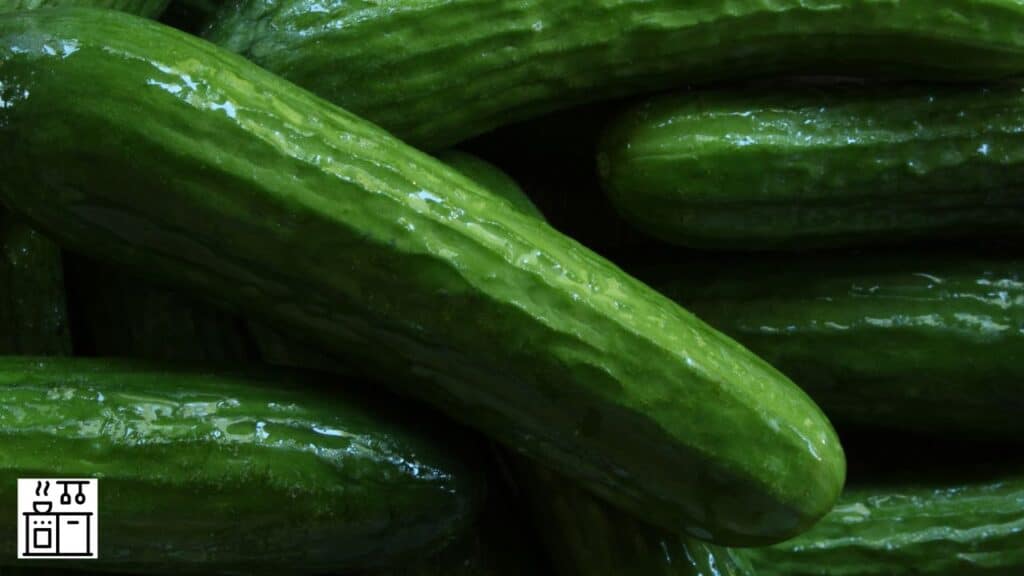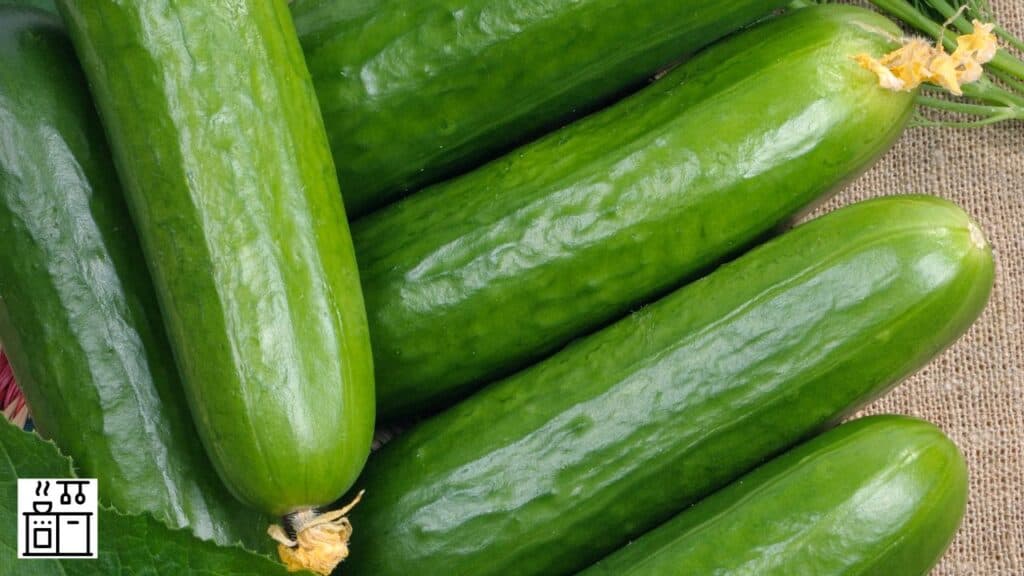Cucumbers and melons are similar in many ways. Both are seedy vegetables. They are moist and juicy.
These similarities may make you wonder if cucumbers are melons.
- 10 Reasons Why Cucumbers Aren't Melons
- 1. They belong to different plant groups.
- 2. Their leaf shapes are different.
- 3. The appearance of foliage on the plants differs.
- 4. Melons take longer to grow.
- 5. They are different in flavor.
- 6. Cucumber skin is edible.
- 7. They have different shapes.
- 8. They have different nutritional values.
- 9. Cucumbers and melons can't cross-pollinate.
- 10. Cucumbers are used as vegetables.
- Takeaway
10 Reasons Why Cucumbers Aren’t Melons
The growing requirements of cucumbers and melons are the same. Hence, they can grow in the same space.
However, there are stark differences between both varieties of plants.
Let’s explore these differences in detail.
1. They belong to different plant groups.
Both cucumbers and melons belong to the cucurbit family. However, they fall under different sub-groups.
Cucumbers belong to a group called Cucumis Sativis.
Another vegetable that belongs to this group is squash.
Melons, however, belong to a group called Cucumis Melo.
This group includes different melons, including watermelon and cantaloupe.
One of the main differences between these plant groups is their DNA structure.
Cucumbers have only 7 chromosomes, while melons have 12.
So, they are essentially different at the cellular level.
Interesting Reading:
2. Their leaf shapes are different.
If cucumbers and melons grow near each other, you can distinguish them based on the shape of their leaves.
Cucumber leaves are triangular with light lobes at the base. They have pointed ends.
You will notice that they look like maple leaves.
Meanwhile, melon leaves are more rounded. They have three main deep-cut lobes.
They are further divided into smaller lobes. Melon leaves are more like oak leaves.
In addition to the structure, the color of the leaf also differs.
Cucumber leaves are dark green without patches or designs on the surface.
However, watermelon leaves have a distinct white mottling on their green surface.
They aren’t as dark green as cucumbers.
3. The appearance of foliage on the plants differs.
The foliage distribution of cucumbers and melons on the vines differs.
If you observe the leaf cover, you will notice that cucumber produces a dense canopy of leaves.
The leaves shield the fruits from sunlight and offer good shade. However, melon foliage isn’t as dense.
Another noticeable difference is that the veins on melon leaves are lighter than the color of the leaf blade.
Cucumber leaf veins look like dark creases that are spread all over the leaf.
The tendrils on these plants also differ. Melons have strong tendrils that attach tightly.
They are nearly impossible to release.
Cucumber tendrils are delicate. Although they fasten to nearby surfaces, they aren’t too strong.
You can easily release them.
4. Melons take longer to grow.
Both cucumbers and melons grow well under the right conditions. They don’t require much care.
They mainly need plenty of sunlight and well-drained soil to grow abundantly.
These plants thrive in soils that are rich in potassium and phosphorus.
However, the growth time varies for both fruits.
Cucumbers grow faster than melons.
After you plant the seedlings, the fruits are ready for harvest in fifty days or slightly longer.
However, melons take much longer to produce fruit.
They typically need eighty days to grow to full size and be ready for harvest.
5. They are different in flavor.
Cucumbers and melons are moisture-rich vegetables. However, they have different flavor profiles.
Melons are sweet because they have more sugar than cucumbers. This makes them taste sweeter.
Meanwhile, cucumbers have low sugar content. They have a low glycemic index (GI).
6. Cucumber skin is edible.

You can eat cucumbers whole because their skin and seeds are edible.
Even while pickling, you can keep the skin intact. The skin is a good source of roughage.
However, you can also peel the skin off cucumbers if you prefer.
The skin of some cucumber varieties is bitter and hence not great for eating.
However, all melons have hard, inedible skin. It’s thick and doesn’t taste good.
Hence, you should always remove the skin of melons before consumption.
The thick skin helps to extend the melon’s shelf-life. Cucumbers don’t last as long because of their thinner skin.
7. They have different shapes.
Cucumbers appear as tiny round globes on the vines. However, they become longer and cylindrical as they grow.
When fully grown, cucumbers are cylindrical with rounded edges.
A few varieties, like the Indian cucumber and apple crystal cucumber, are round.
However, these are rare exceptions.
Melons are generally round and big vegetables. They are green when unripe but change color as they ripen.
Depending on the variety, they can turn yellow or orange by the time they are ready for harvest.
Related Reading: 12 Cucumber Varieties that Turn Yellow when Ripe
8. They have different nutritional values.
The nutritional makeup of melons and cucumbers differs.
We already saw that melons have a higher sugar content than cucumbers.
In addition to this, there are various other differences in nutritional value as well.
Cucumbers contain 95% water. They are a good source of Vitamin K, potassium, and fiber.
They also have trace elements and roughage.
Although we classify them as vegetables in the culinary sense, they are botanically classified as fruits.
Melons have different nutritional constituents depending on the type.
These fruits are also moisture-rich. However, their water content isn’t as high as cucumbers.
Melons typically have only 90% to 92% water.
Melons are generally good sources of carbohydrates and natural sugars.
They also contain minerals like phosphorus, potassium, and magnesium in trace amounts.
Melons are high in fiber.
9. Cucumbers and melons can’t cross-pollinate.
In the plant kingdom, only plants of the same species can cross-pollinate.
Although cucumbers and melons share various physical similarities, they can’t cross-pollinate.
So they will not produce viable offspring if you plant them near each other.
The reason for this is the difference in their chromosomal structure.
We already saw that cucumbers have only 7 chromosomes.
Meanwhile, melons have 12 chromosomes.
For either of these fruits to cross-pollinate and produce offspring, they should cross-pollinate with partners that have similar cellular makeup.
Since the number of chromosomes is different in cucumbers and melons, they can’t reproduce with each other.
Other cucurbits like zucchini and pumpkin cross-pollinate to produce exciting hybrids because they are from the same species.
However, it’s not the case for cucumbers and melons.
You can grow cucumbers and melons together because they thrive in the same environment.
10. Cucumbers are used as vegetables.
Cucumbers are botanically classified as fruits because they contain viable seeds.
However, in the culinary world, they are called vegetables.
Since these vegetables have low sugar content, they aren’t used for desserts.
They are either eaten raw, used in sandwiches, pickled, or used in salads.
Meanwhile, melons are generally considered fruits. They have a higher sugar content than cucumbers.
The presence of sugar makes them sweet. So, you can eat them raw.
They are sometimes also used in dessert and sweet recipes.
Takeaway
Despite their physical similarities, cucumbers aren’t melons.
Cucumbers and melons belong to different groups. They can’t cross-pollinate and produce fruits.
If you study both plants carefully, you will also notice significant differences in the way they grow and the appearance of their foliage and fruits.

